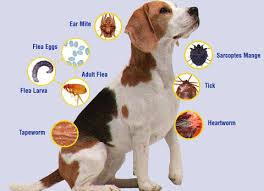Worms….They’re everywhere!
It’s that time of year, the bugs and parasites are out! We thought we would take time to remind everyone of the different types of worms that can affect your pets.
Most people are familiar with the intestinal parasites; these are the worms that you will find in your pets’ poop! No it isn’t a very pleasant thought, but that’s where they live. So what are symptoms of intestinal parasites and what are we looking for? Some types of worms you will actually see in the stool, this includes roundworms (they look like spaghetti) and tapeworms (they look like pieces of rice or sesame seeds). Other types may have to be identified by looking for their eggs under the microscope. This includes whipworms and hookworms. To identify these it will require a sample being dropped off to your veterinarian’s office. Symptoms can vary from weight loss, loose stools, or just a dull hair coat. A great place to start is by checking a stool sample.

So how did your pet get these fun little critters? Well there are several ways. Most of the time they come from the environment or soil, if your pet is young they could have contracted them from their mother, or if it is a tapeworm issue these are usually obtained from ingesting fleas or rodents. Most of the time these types of worms can be treated with medication and your pet may never have another issue. However, sometimes the environment will also need to be treated to prevent re-infestation
Another type of worm that we are contending with is the heartworm. These are actually transmitted by mosquitoes and live in the heart and lungs so most pets will have no external signs. It is very easy to prevent heartworm disease. There are monthly topical or oral preventatives that can be given to dogs. It is much cheaper (and safer) to prevent heartworms rather than try to treat them once your dog is infected.

Finally one other interesting type of worm, is a worm that can actually be found in your dog’s skin! While this is not very common we did recently have one case of it. It is usually from a dog drinking a contaminated water source and the worm then migrates to the skin and forms a home in your dog skin that begins to bulge. Once the entire worm is removed from this area your dog should have no further problems. Again this is not very common but it is an interesting place you can find worms!
If you have any questions or want more information about any of the worms (transmission, prevention, treatment) mentioned above please just let us know! We’d be happy to help!
